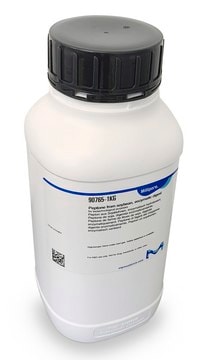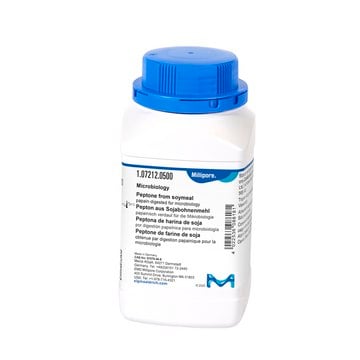P0521
Peptone from Glycine max (soybean)
Type IV, powder, Component of microbiological growth media
Synonyme(s) :
Protein from soybean, Soya peptone type IV
About This Item
Produits recommandés
Source biologique
Glycine max (soybean)
Niveau de qualité
Stérilité
non-sterile
Type
Type IV
Forme
powder
Dosage de l'azote
~2.0% amino, ~8.0% total
Application(s)
food and beverages
microbiology
vitamins, nutraceuticals, and natural products
Température de stockage
10-30°C
Catégories apparentées
Description générale
Application
Peptone from Glycine max as a nutrient, displays comparative or better growth features of cultivated microorganisms than peptone from other sources
Code de la classe de stockage
11 - Combustible Solids
Classe de danger pour l'eau (WGK)
WGK 1
Point d'éclair (°F)
Not applicable
Point d'éclair (°C)
Not applicable
Équipement de protection individuelle
Eyeshields, Gloves, type N95 (US)
Choose from one of the most recent versions:
Certificats d'analyse (COA)
Don't see the Right Version?
If you require a particular version, you can look up a specific certificate by the Lot or Batch number.
Déjà en possession de ce produit ?
Retrouvez la documentation relative aux produits que vous avez récemment achetés dans la Bibliothèque de documents.
Les clients ont également consulté
Articles
Culture media provides a habitat with suitable nutrients, energy sources, and certain environmental conditions for the growth of microorganisms. The components of the culture media range from simple sugars to peptones, salts, antibiotics, and complex indicators.
Notre équipe de scientifiques dispose d'une expérience dans tous les secteurs de la recherche, notamment en sciences de la vie, science des matériaux, synthèse chimique, chromatographie, analyse et dans de nombreux autres domaines..
Contacter notre Service technique














